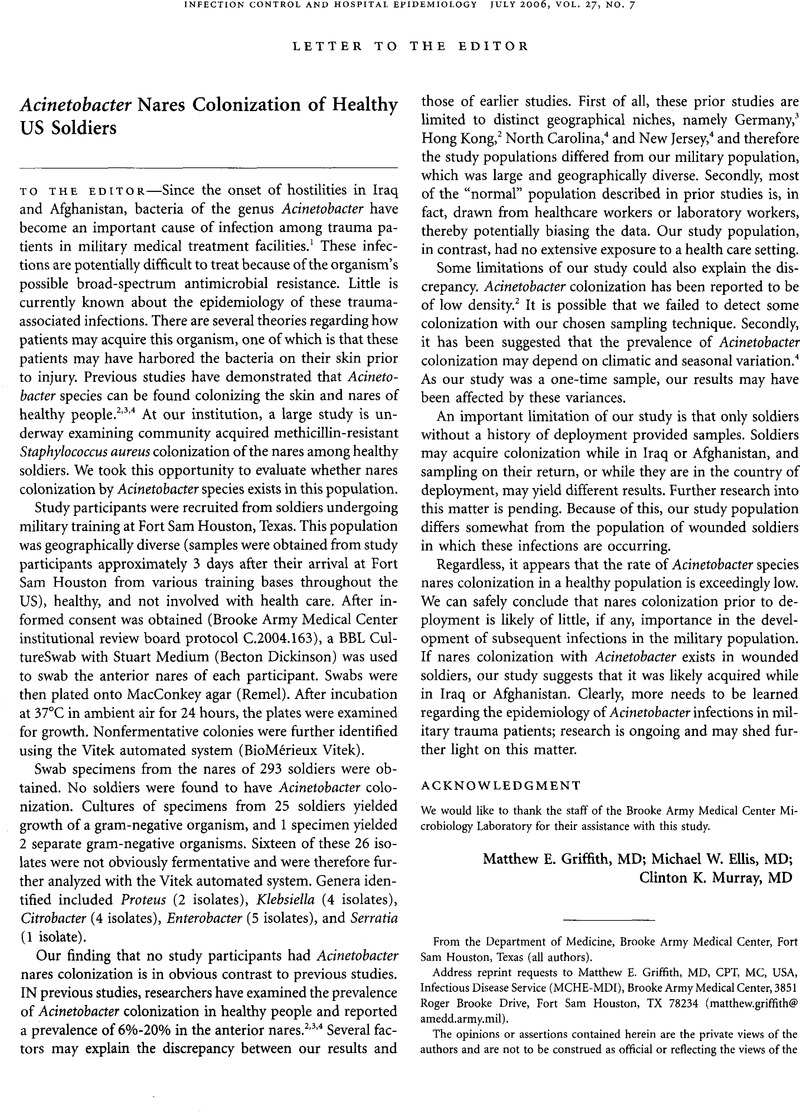Crossref Citations
This article has been cited by the following publications. This list is generated based on data provided by Crossref.
Peleg, Anton Y.
Seifert, Harald
and
Paterson, David L.
2008.
Acinetobacter baumannii
: Emergence of a Successful Pathogen
.
Clinical Microbiology Reviews,
Vol. 21,
Issue. 3,
p.
538.
Moran, Kimberly A.
Murray, Clinton K.
and
Anderson, Edwin L.
2008.
Bacteriology of Blood, Wound, and Sputum Cultures from Non-US Casualties Treated in a Combat Support Hospital in Iraq.
Infection Control & Hospital Epidemiology,
Vol. 29,
Issue. 10,
p.
981.
Aronson, Naomi E.
2008.
Infections Associated with War: the American Forces Experience in Iraq and Afghanistan.
Clinical Microbiology Newsletter,
Vol. 30,
Issue. 18,
p.
135.
Murray, Clinton K.
2008.
Infectious disease complications of combat-related injuries.
Critical Care Medicine,
Vol. 36,
Issue. Suppl,
p.
S358.
Murray, Clinton
Scott, Paul T.
Moran, Kim A.
and
Craft, David W.
2008.
Acinetobacter Biology and Pathogenesis.
p.
197.
Murray, Clinton K.
and
Hospenthal, Duane R.
2008.
Acinetobacter Infection in the ICU.
Critical Care Clinics,
Vol. 24,
Issue. 2,
p.
237.
Paterson, David L.
and
Peleg, Anton Y.
2009.
Antimicrobial Drug Resistance.
p.
819.
Johnson, Erica N.
Marconi, Vincent C.
and
Murray, Clinton K.
2009.
Hospital-Acquired Device-Associated Infections at a Deployed Military Hospital in Iraq.
Journal of Trauma: Injury, Infection & Critical Care,
Vol. 66,
Issue. 4,
p.
S157.
Hospenthal, Duane R.
Green, Andrew D.
Crouch, Helen K.
English, Judith F.
Pool, Jane
Yun, Heather C.
and
Murray, Clinton K.
2011.
Infection Prevention and Control in Deployed Military Medical Treatment Facilities.
Journal of Trauma: Injury, Infection & Critical Care,
Vol. 71,
Issue. 2,
p.
S290.
O'Shea, M.K.
2012.
Acinetobacter in modern warfare.
International Journal of Antimicrobial Agents,
Vol. 39,
Issue. 5,
p.
363.
De Vos, Daniel
Pirnay, Jean-Paul
Bilocq, Florence
Jennes, Serge
Verbeken, Gilbert
Rose, Thomas
Keersebilck, Elkana
Bosmans, Petra
Pieters, Thierry
Hing, Mony
Heuninckx, Walter
De Pauw, Frank
Soentjens, Patrick
Merabishvili, Maia
Deschaght, Pieter
Vaneechoutte, Mario
Bogaerts, Pierre
Glupczynski, Youri
Pot, Bruno
van der Reijden, Tanny J.
Dijkshoorn, Lenie
and
Gao, Feng
2016.
Molecular Epidemiology and Clinical Impact of Acinetobacter calcoaceticus-baumannii Complex in a Belgian Burn Wound Center.
PLOS ONE,
Vol. 11,
Issue. 5,
p.
e0156237.
Weintrob, Amy C.
Murray, Clinton K.
Xu, Jiahong
Krauss, Margot
Bradley, William
Warkentien, Tyler E.
Lloyd, Bradley A.
and
Tribble, David R.
2018.
Early Infections Complicating the Care of Combat Casualties from Iraq and Afghanistan.
Surgical Infections,
Vol. 19,
Issue. 3,
p.
286.
Klotz, Peter
Higgins, Paul G.
Schaubmar, Andreas R.
Failing, Klaus
Leidner, Ursula
Seifert, Harald
Scheufen, Sandra
Semmler, Torsten
and
Ewers, Christa
2019.
Seasonal Occurrence and Carbapenem Susceptibility of Bovine Acinetobacter baumannii in Germany.
Frontiers in Microbiology,
Vol. 10,
Issue. ,
Blyth, Maj Dana M.
and
Yun, Col Heather C.
2022.
Musculoskeletal Infection.
p.
335.





